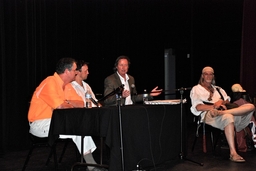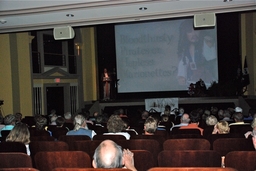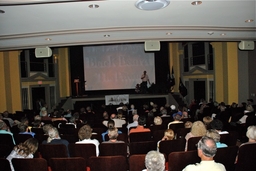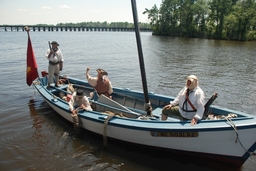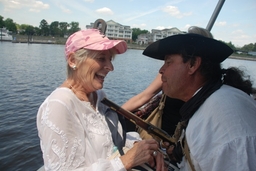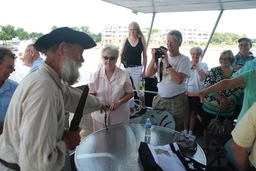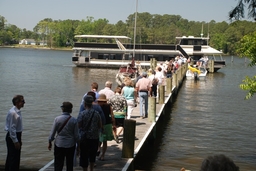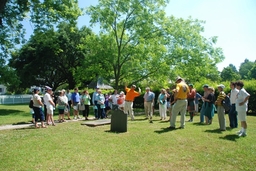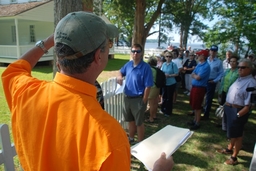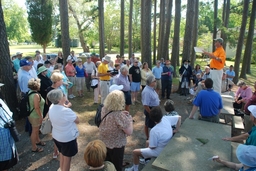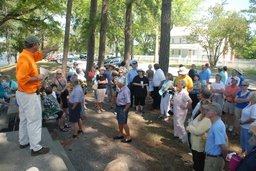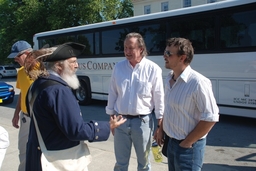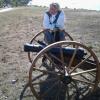
LookingGlass
Member-
Posts
82 -
Joined
-
Last visited
Content Type
Profiles
Forums
Events
Gallery
Everything posted by LookingGlass
-
I know of two sources for the statement that surgeons were forcibly retained aboard the French slaver formerly named La Concorde--one secondary source and one primary source. The secondary source comes from "In Search of Blackbeard: Historical and Archeological Research at Shipwreck Site 003BUI," Richard Lawrence and Mark Wilde-Ramsing authors, published in Southeastern Geology February 2001: "The cabin boy and three of his fellow French crewmen voluntarily joined the pirates, and ten others were taken by force including a pilot, three surgeons, two carpenters, two sailors, and the cook." The primary source comes from the signed deposition of La Concorde's former captain, Pierre Dossett, given upon his return to Nantes on 13 October 1718 after surrendering his ship to Edward Thatch in the Windward Islands. Dossett listed the fate of his crew members including those who died enroute. Dossett indicated that Jean Dubert d'Arzal, "chirurgien," returned to Nantes aboard an English vessel. The two "aides chirurgiens," Marc Bourgneuf and Nicholas Gautrain, remained with the newly named Queen Anne's Revenge. Therefore, based on the Dossett deposition, it would seem that only two surgeon's aides were conscripted by Thatch.
-
Yes, writers such as Konstam and Woodard have suggested that Blackbeard threatened to sail across the bar and attack the town of Charleston. When a source is cited, the source is often Johnson's GHP. However, 19th century historian Edward McCrady wrote, "It is altogether improbable that Thatch would have ventured his 40 guns against 100 which lined the fortifications of the town, and risked his vessels in the harbor where they would have had him under such a disadvantage" (McCrady, The History of SC Under the Proprietary Government 1670-1719). I am more inclined to trust McCrady. As for the colorful account of the bombardment and burning of Guadeloupe town found in Woodard, p. 216, the Calendar of State Papers provide the following information. Governor Hamilton to the Council of Trade and Plantations. "In my turning up to windward we did see another pirate ship and a large sloop which we were informed when we came off of the Island St. Eustatius by a sloop sent express from St. Christopher's were two other pirates that had two days before taken some of the trading sloops off of that Island and sunk a ship loaden with white sugar etc. just under Brimstone Hill which they had taken under Guadaloupe shore. The ship is commanded by one Captain Teatch, the sloop by one Major Bonnett an inhabitant of Barbadoes, some say Bonnett commands both ship and sloop. This Teatch it's said has a wife and children in London, they have comitted a great many barbarities; The ship some say has 22 others say she has 26 guns mounted but all agree that she can carry 40 and is full of men the sloop hath ten guns and doth not want men... Signed, W. Hamilton. Endorsed, Recd. 7th, Read 11th March, 1717/18" Deposition of Thomas Knight. "These and the ship they had taken out of Guardalupa spying some vessels in Nevis, and among the rest took one for the man of warr, they said they would cut her out, but the Captain being ill prevented it etc. Confirms preceding. They report the Captain of the pirates name is Kentish and Captain Edwards belonging to the sloop, and they report the ship has 150 men on board and 22 guns mounted, the sloop about 50 white men, and eight guns, and that they burnt part of Guardalupa, when they cut out the French ship. Signed, Thos. Knight." The "man of warr" Knight referred to has been suggested to be the HMS Scarborough, which Johnson claimed Teach had engaged "for some hours." We're reasonably certain that did not happen. Unless someone can produce a French document that verifies the burning of the town by Thatch, Teach, Teitch, Capt. Kentish, Blackbeard, etc., we can't be certain that happened as well.
-
I'd like to refresh my memory about the Guadeloupe event. What is your source for the statement that Blackbeard attacked Guadeloupe? As for Charleston, I don't think it can be said that BB attacked the town. None of his vessels crossed the bar and entered the harbor.
-
The aforementioned "evidence" cited in Woodard (p.213) hardly makes the thesis "very dubious." The statement that because Blackbeard did not retain all 455 slaves means that his interest in La Concorde was in "it's combat and sailing capabilities" can be said to be just as speculative. No author or historian has yet to cite source documents that prove one way or the other why Blackbeard sailed from the Delaware capes directly to the north of Barbados in November 1717 and captured an inbound ship from Africa. Woodard's notes offer no sources for the statement, "As he looked over his new prize, Blackbeard knew he had finally found a proper flagship..." There also seems to be little consideration as to how the addition of 455 slaves to Blackbeard's company of 200 to 250 pirates (letter of Charles Mesnier, Intendant of Martinique, and deposition of Thomas Knight,Jan. 6, 1718, CSPCS Vol. 30, #298. ii) would have stressed the ship's provisions and water, nor does it take into consideration the physical condition of the majority of the slaves. It is possible that the value of the 61 slaves Blackbeard's company gleaned from the La Concorde's cargo were worth considerably more than a greater number of slaves they left behind with Captain Pierre Dosset. Furthermore, it might safely be assumed that the 61 Africans from La Concorde's cargo could not speak English nor had useful skills other than performing the laborious, menial tasks. They were unlikely to have been assimilated into the pirate crew. As for the question of whether the capture of La Concorde was for her cargo or her fighting capabilities, it must be noted that the slaves remained with Blackbeard longer than the ship. Granted, it could be argued against the "true treasure" thesis that once the QAR was wrecked, there was no longer any need for the majority of the slaves, hence they were sold at Bath. However, I submit that neither argument is superior as in providing the best explanation for why Blackbeard and the 40 or so crew who sailed with him from Beaufort Inlet delivered slaves to Bath, a plantation community that had few slaves. Other questions remain unanswered. How were the slaves accommodated aboard the QAR during the 7 months after departing from Bequia? So far, few shackles have been recovered from the wreck, although much of the wreck remains on the ocean bottom. There is little uncertainty as to possibility that "the slaves escaped en masse." A pamphlet attributed to the Virginia House of Burgesses reprinted in Virginia Magazine of History and Biography (XXII, pps. 414-415, 1914) states, "Understanding that there was a good deale of money and a great many Negroes in the case, [spotswood] persuades the King's Men of War to surprise and Kill the men within the Country of Carolina."
-
I suspect that someone of authority has finally faced the reality (after 15 years of stewardship) that they can't effectively seek private funding to support the recovery of a ship the identity of which is uncertain. The evidence hasn't really gotten any stronger in recent years but taxpayer funding has substantially diminished and is soon to disappear. The confirmation could, and should, have been announced 10 years ago. Unfortunately, NC has always been slower than her neighboring states when it comes to developing her historical resources.
-
Was Blackbeard's Caesar hanged? That's a good question that cannot be answered with absolute certainty. I'm not sure he was. The only source that states that Caesar was hanged was Johnson's GHP. The "King's warrant for payment of 710 British pounds to Captain George Gordon and others for capture or killing of 'Thatch a Notorious Pyrate' and his crew" (1722 Sept. 19, PRO-T 52/32) lists a Caesar as a convicted pirate along with four known Africans, Richard Stiles, Thomas Gates, James Blake and James White (identified as African slaves in NC Council Journal, hearing of evidences against Tobias Knight Esq., Secretary of this Province, May 27, 1719, NC Col. Rec. II, pps. 341-349). In his testimony, Knight states that evidence presented against him by the four Africans "ought not to be taken against him for that they are (tho cunningly couched under the names of Christians) no other the four Negro Slaves which by the Laws and customs of all America Aught not to be Examined as Evidence." Later in his testimony, Knight said, "neither did the said Tobias Knight or any of his family contract any acquaintance with the said Thache or any of his crew nor did deal buy or Sell any with or any of them dureing their whole stay Save only Two Negroe men which the said Knight purchased from Two men who had left the said Thache and had rece'd their pardons and since are gone Lawfully out of this Goverment." Tobias Knight died within the following few months because the inventory of his estate (Beaufort Co. Deed Book 7, entry 403) was appraised by September 15, 1719. Listed in the inventory are the entirety of his slaves: "negro man Jack age 60 £10, negro man Tom age 40 £20, negro man Pompey age 27 £60, negro man Caesar age 24 £60, negro girl Phillis age 12 £35, Indian boy Scipio age 8 £15." It seems to be most probable that Knight purchased the two men in their 20s from the two members of Thache's crew, who were each valued at a significantly higher price than the others. Johnson's GHP lists a James Robbins as having been hanged at Williamsburg but Robbins's name does not appear on the King's warrant. A James Robbins first appears in the Beaufort Co. Deed Book on Sep. 9, 1718, when he and fellow "mariner" Stephen Elsey purchase the former 400 acre plantation of Gov. Charles Eden for 3 male negro slaves (this plantation adjoined Tobias Knight's plantation along Bath Creek). This same James Robbins was identified in a deposition (Beaufort Co. Deed Book 4, entry 262) as having, sometime in January 1718/1719 bedded with "both Elizabeth Goodin and Sarah Montague & said Elizabeth asked him why he came to bed with his breeches on and he removed them." If this was the same James Robbins identified by Johnson as having been hanged at Williamsburg, he would seem to have somehow 'slipped the noose.' A discussion of the repetition of names listed on the King's warrant of convicted pirates, appearing in Johnson as hanged pirates, and appearing in the Beaufort Co. Deed Books during the years following the so-called executions, has appeared here in Twill previously, especially the story of the pirate-cooper Edward Salter. This post is limited to the Africans on Blackbeard's crew and their respective fates. On the 11th of March 1718/1719, Lt. Gov. Spotswood addressed his Council "that five Negroes of the crew of Edward Tack and taken on board his Sloop remain in Prison for Piracy... [and] whether there be anything in the Circumstances of these Negroes to exempt them from undergoing the same Tryal as other pirates." The Council concluded that "the said Negroes being taken on Board a Pyrate Vessell and by what yet appears equally concerned with the rest of the Crew in the same Acts of Piracy ought to be Try'd in the same Manner." Unfortunately, the trial records have been lost and we don't know the actual disposition of the cases of the five Africans, whom we can fairly assume were Richard Stiles, Thomas Gates, James Blake, James White, and Caesar. In his History of North Carolina, Vol. II, p.8 (PHILADELPHIA: THOMAS DOBSON, 1812), Hugh Williamson wrote, "The pirates, who survived the action, were tried in Virginia. One of them, Basilica Hand, turned king's evidence; and four of them were executed." Similarly, Rev. Dr. Shirley Carter Hughson (The Carolina Pirates and Colonial Commerce, 1670-1740, Johns Hopkins Press, 1894) wrote, "They [the trials] were held at Williamsburgh, and four of the accused were condemned and afterwards hanged." The sources for both Williamson and Hughson's statements that "four" were executed are not known. Again, the Virginia trial records of the pirates are no longer extant. It is worth noting that Tobias Knight stated in his testimony that only four of the five "Negroes of the crew of Edward Tack and taken on board his Sloop remain in Prison for Piracy" presented evidence against him. Why did not the fifth man testify against Tobias Knight? Were there two Caesars? I don't think so. Should we accept Johnson's word that Caesar was hanged? I'm not so sure.
-
"In other words, the author has an unprovable and somewhat controversial theory and he's going to amass a whole mess of circumstantial evidence that doesn't prove it, but sounds pretty good when strung together with helpful explanations of how the scattered data fits his theory." I am not sure I understand your point. This article is about how Blackbeard departed Beaufort Inlet with 60 Africans (David Herriott deposition, Charleston trial of pirates captured with Stede Bonnet, Nov. 1718), but only had six Africans aboard the sloop Adventure during the Battle at Ocracoke. Members of Blackbeard's crew were known to have sold slaves to Bath residents (Tobias Knight testimony in 1719) or had slaves in their possession when captured (William Howard). The conclusion is that not all of the 60 Africans who were taken with Blackbeard from Beaufort Inlet were free men. What is unprovable or controversial about that? What controverting facts have been ignored?
-
I'm posting the entire contents of the article in the event that it is not archived by the newspaper: Blackbeard's True Treasure ©2011 Kevin P. Duffus RALEIGH--The whereabouts of the mythical pirate treasure of the notorious Blackbeard has bewitched folks ever since the smoke cleared following the Battle of Ocracoke 292 years ago. Minutes after Blackbeard's death, Royal Navy sailors began a search for the bearded pirate captain's ill-gotten gains. They were soon disappointed. They found no treasure chests of gold, silver or jewels. And despite many enticing claims, nor has anyone else found Blackbeard's lost treasure since that historic November day on North Carolina's Outer Banks. However, there was a treasure, and it likely survives to this day in eastern North Carolina. North Carolina's Department of Cultural Resources proudly boasts – and rightly so – that it has retrieved over the past 15 years more than 250,000 artifacts from the Queen Anne's Revenge, including the anchor recently brought to the surface. Few experts, however, have considered the cargo of flesh and blood transported by the famous ship. This is not the pirate history you will see on the silver screen, find on roadside historic markers, read on museum walls or heard at our state's historic sites. But it is our history. In November 1717, north of Barbados, Blackbeard positioned his flotilla in the path of slave-trading ships arriving from west Africa, where he captured the French slaver La Concorde, renaming her the Queen Anne's Revenge. Historians have surmised that he wanted to capture a big slave ship in order to mount up to 40 guns aboard, making her as powerfully armed as any Royal Navy warship patrolling the West Indies. I believe it was to serve a different purpose. Six months later, near the end of his two-year career of piratical mayhem, Blackbeard sailed to North Carolina and purposely wrecked the Queen Anne's Revenge in the entrance to what is today, Beaufort Inlet. There, records say, he disbanded his 400-man company, marooned some men on an island and tricked all but his closest allies out of all of their communal treasure, and left aboard a fast and nimble sloop he named Adventure. About 10 days later, Blackbeard arrived at Bath, where he surrendered to Gov. Eden and applied for a royal pardon. Depositions filed in Charleston, S.C., later that year by former members of Blackbeard's crew – the ones he left behind at Beaufort Inlet, are well-preserved and very detailed. When Blackbeard and his inner-circle of associates sailed to Bath, they had with them 60 African men. Some pirate historians wax lyrical at the apparent racial diversity of Blackbeard's crew, marveling that 6 out of 10 of Blackbeard's pirates were black. But what the pirate historians don't tell you is that six months later, when Blackbeard was killed at Ocracoke, he had aboard his sloop only six Africans. What happened to the 54 other African men? I believe they were the pirates' secret treasure, a labor force delivered to the impoverished plantation society of the Pamlico region, which was desperately short on manpower and far from the slave markets at Williamsburg, Va., and Charleston. The colony of North Carolina had been wracked by years of political strife, punitive trade restrictions, drought, sickness and war with Indians. As her wealthier neighbors, Virginia and South Carolina, began to grow due to navigable, deepwater ports, the northern colony of Carolina was severely constrained by the vagaries of shoaling inlets, shallow sounds and great distances between her plantations and the travelled byways of the sea. From the beginning, North Carolina settlers struggled to produce the volume of commodities necessary to support their economy because, compared to South Carolina and Virginia, North Carolina had few slaves. "For the want of suitable ports negro slaves were not imported directly into North Carolina, and the planters there were forced to buy from Virginia and South Carolina. And in this very important particular North Carolina was at great disadvantage," wrote Colonial Records editor William Saunders. There is wide gulf of opinion among those who have studied the question – historians such as David Cordingly, Kenneth Kinkor and Marcus Rediker – regarding the status of blacks among pirates and whether they were treated as equals, servants or slaves. Rediker wrote that "Negroes and mulattoes were present on almost every pirate ship, and only rarely did the many merchants and captains who commented on their presence call them slaves." Kinkor even presents examples of blacks who were leaders of predominantly white crews. Conversely, Cordingly wrote that "pirates shared the same prejudices as other white men in the Western world. They regarded black slaves as commodities to be bought and sold, and used them as slaves on board their ships for the hard and menial jobs." Having analyzed the references found among the primary sources pertaining to Africans among Blackbeard's crew after June 1718, I would have to agree with Cordingly's assessment. The 60 blacks who departed Beaufort Inlet aboard the sloop Adventure were most certainly treated as commodities to be bought and sold, and were used as servants to do the hard and menial jobs. For example, four blacks named Richard Stiles, Thomas Gates, James Blake and James White, accompanied Blackbeard on an arduous 36-hour, 95-mile round trip journey across the Pamlico Sound for a mysterious midnight visit to Bath on Sept. 14, 1718. Records indicate that the black crew member's jobs were to row the Adventure's launch. They were in all likelihood Blackbeard's servants or slaves – men who were perhaps trusted to carry arms, but servants or slaves just the same. As an example of the value that slaves held in the 1718 economy of Bath, the Beaufort County deed book shows that Stephen Elsey and James Robins, two mariners who appear in the records shortly after Blackbeard's arrival in North Carolina suggesting that they may have been former members of his crew, purchased Gov. Eden's former 400-acre plantation, house and outbuildings on Bath Creek, for the price of three slaves named Barsue, Lawrence and John. This same property was sold again eight years later to Blackbeard's cooper-turned-merchant, assemblyman and patron of Bath's St. Thomas Church, Edward Salter, for £600. Records reflect that other slaves were sold by members of Blackbeard's crew, including two to Customs Collector Tobias Knight – probably 26-year-old Pompey and 23-year-old Caesar, each valued a year later at £60. Former quartermaster William Howard was apprehended in Virginia with two African slaves after having retired from Blackbeard's crew at Bath. According to a letter from Virginia's Lt. Gov. Spotswood, Howard admitted that his slaves had "been piratically taken." Over six months, Blackbeard's company acquired, traded and gleaned the healthiest, fittest, strongest African men and then delivered them to North Carolina's destitute settlement of Bath – the very place in colonial America that needed them the most. Using a popular calculator for measuring worth of historical prices (MeasuringWorth.com), Blackbeard's flesh and blood "treasure" in 1718 would be worth millions in today's dollars. It has long been whispered among a number of eastern North Carolina families that they consider themselves descendants of pirates. Until now, few people have taken the time to remember the untold numbers of black families whose roots might lead to the 60 African slaves brought in by pirates in the summer of 1718. The importation of African slaves is the forgotten legacy of the Great Age of Piracy, and an unappreciated but important part of North Carolina's heritage. Who knows who might be related to Barsue, Lawrence and John, or Tobias Knight's Pompey and Caesar, or the pirate-cooper Edward Salter's Priamus the shoemaker, Toney, Aberdeen, Cimrick and Tom? I list their names here so that they might not be forgotten. It was by their heartache, their labors, their suffering, and by the sacrifices of their families and others who shared their plight, that eastern America was wrought out of wilderness. The slaves brought to North Carolina by Blackbeard in 1718 were a true treasure, indeed. Perhaps someday they will be so remembered by our historical community. Kevin P. Duffus of Raleigh is the author of "The Last Days of Black Beard the Pirate – Within Every Legend Lies a Grain of Truth."
-
Blackbeard’s True Treasure ©2011 Kevin P. Duffus RALEIGH--The whereabouts of the mythical pirate treasure of the notorious Blackbeard has bewitched folks ever since the smoke cleared following the Battle of Ocracoke 292 years ago. Minutes after Blackbeard’s death, Royal Navy sailors began a search for the bearded pirate captain’s ill-gotten gains. They were soon disappointed. They found no treasure chests of gold, silver or jewels. And despite many enticing claims, nor has anyone else found Blackbeard’s lost treasure since that historic November day on North Carolina’s Outer Banks. However, there was a treasure, and it likely survives to this day in eastern North Carolina. North Carolina’s Department of Cultural Resources proudly boasts – and rightly so – that it has retrieved over the past 15 years more than 250,000 artifacts from the Queen Anne’s Revenge, including the anchor recently brought to the surface. Few experts, however, have considered the cargo of flesh and blood transported by the famous ship. This is not the pirate history you will see on the silver screen, find on roadside historic markers, read on museum walls or heard at our state’s historic sites. But it is our history. More here: http://www.newsobser...e-treasure.html
-
From the album: Pirate Parley on the Pamlico
Dr. Charlie Ewen, Ed Fox, Kevin Duffus and Cap'n Pern of Blackbeard's Crew. -
Pirate Parley on the Pamlico
Images added to a gallery album owned by LookingGlass in Pub Members Gallery
photos of the archaeological tour of Bath, NC, cruise to Washington, attack and boarding by the Devilmen of the Cape Fear, and Parley at the historic Turnage Theatre. -
From the album: Pirate Parley on the Pamlico
-
From the album: Pirate Parley on the Pamlico
Parley -
From the album: Pirate Parley on the Pamlico
Devilmen of the Cape Fear--they were terrific and very kind to participate! -
From the album: Pirate Parley on the Pamlico
Pat Mansfield, president of Black Beard Adventure Alliance, host for the Parley -
From the album: Pirate Parley on the Pamlico
boarding by pirates -
From the album: Pirate Parley on the Pamlico
boarding the cruise at the Bath town dock -
From the album: Pirate Parley on the Pamlico
Dr. Charlie Ewen, ECU archaeologist discusses colonial Bath with attendees -
From the album: Pirate Parley on the Pamlico
Dr. Charlie Ewen, ECU archaeologist discusses colonial Bath with attendees -
From the album: Pirate Parley on the Pamlico
Dr. Charlie Ewen, ECU archaeologist discusses colonial Bath with attendees -
From the album: Pirate Parley on the Pamlico
Dr. Charlie Ewen, ECU archaeologist discusses colonial Bath with attendees -
From the album: Pirate Parley on the Pamlico
Rob aka Dutchman of Meka II speaks with Kevin Duffus and Ed Fox -
Picking up Foxe at the airport in a few hours! Visiting the QAR Lab tomorrow and then on to the Pirate Parley on the Pamlico. Hope to see you there. A memorable weekend to be sure.
-
For Immediate Release Contact: 252-948-0550 Rare 1724 Book That Launched Pirate History to be Displayed at Pirate Parley Event in Washington, NC, on May 21 WASHINGTON, NC—It is the 287-year-old book that launched pirate history, turned ordinary rogues and thieves like Blackbeard and Calico Jack Rackham into world-famous legends and provided the basis of historical knowledge which has since been perpetuated by hundreds of books, dozens of movies and pop-culture’s perception of pirates. First published in 1724 during the waning days of the Great Age of Piracy, A General History of the Robberies and Murders of the Most Notorious Pyrates is considered to be the ‘bible’ of pirate history. The author, Captain Charles Johnson, has been called the “famous historian of scoundreldom” despite the fact that nobody really knows who he was or from what sources he derived his information. Johnson later wrote a second volume, completing chapter-length biographies of 35 of the western hemisphere’s best known “highwaymen” of the sea. The books were so popular in London they could not be printed fast enough. A rare, 2nd edition 1724 copy of the first volume and a 1728 copy of the second volume from East Carolina University’s Joyner Library will be on display in the lobby of the historic Turnage Theatre on Main St. in Washington, NC, on May 21, 2011, as part of an exhibit titled, “Interpretations of Blackbeard In Fact, Fiction & Folklore.” The exhibit will feature books, movie posters and artwork depicting North Carolina’s infamous pirate captain. The exhibit is a feature of the inaugural PIRATE PARLEY on the Pamlico, a one-day symposium and river cruise on Saturday, May 21, 2011, at Washington and Bath, North Carolina. The PIRATE PARLEY was created to offer more accurate historical views of pirates than pop-culture, Hollywood depictions, coinciding with the premiere of Pirates of the Caribbean—On Stranger Tides which features what Disney Studios describe as "the real-life" Blackbeard teaming-up with Captain Jack Sparrow, mermaids and zombies in a quest for the Fountain of Youth. Much of what the public believes is true about pirates such as Captain Kidd, Anne Bonny, Henry Every, Black Sam Bellamy and Edward Teach, hinges of the veracity and scholarship of Charles Johnson. However, pirate scholars like England’s E.T. Fox, who will be a presenter at the PARLEY, have found numerous factual errors in Johnson’s books, including an entire chapter devoted to a pirate who never actually existed. Most of the best known images of Blackbeard—slow-burning fuses under his hat to frighten his victims, his pact with the devil over the location of his hidden treasure, and his purported 14 wives—are all the result of Johnson’s books. At 3 p.m. on May 21, 2011, the Parley will convene at the historic Turnage Theatre for two fascinating presentations. Noted historian E.T. Fox from Brixham, England, curator of the Sir Francis Drake-Golden Hind museum ship and author of The King of the Pirates—The Swashbuckling Career of Henry Every, will explain the historical realities of pirates and their differences from pop-culture depictions in film and literature. Kevin P. Duffus, a North Carolina filmmaker, journalist, decoder of maritime mysteries, and author of The Last Days of Black Beard the Pirate, will present a new, provocative program titled, “Bloodthirsty Pirates or Hapless Marionettes?” Following the afternoon sessions, attendees will be encouraged to dine at their downtown restaurant of choice from 5:30 to 7:30 p.m. At 7 p.m. the doors of the Turnage will reopen for music, a presenter book signing, and the exhibit “Interpretations of Blackbeard In Fact, Fiction & Folklore.” At 7:30 p.m., the PIRATE PARLEY on the Pamlico will resume with a spirited, free-wheeling roundtable discussion of pirates, Black Beard, archaeology, history, folklore and legends, featuring E.T. Fox, Charles Ewen, Kevin Duffus and questions from the audience. Tickets for the Parley sessions at the Turnage Theater are $20 per person, $15 for groups of 10 or more, and $10 for students. Tickets may be purchased by calling the Blackbeard Adventure Alliance (BAA) office at 252-948-0550. Media inquiries should be directed to 919-845-9244. Additional information may be soon found at BAA’s website: http://blackbeardsloopadventure.com/ Parley presenters E.T. Fox, Charles Ewen, and Kevin Duffus are available for interviews, quotes or additional information. Call 919-845-9244 for media inquires.
-
"I hope you are going to have audio visual capability... slides of reality vs Myth would be cool." Mr. Foxe is going to have a 12,000 lumen projector at hand, which should be sufficient to shed light on the subject. We are also hoping to have a 1724 2nd edition of Johnson's GHP present in case we run short of myths!

